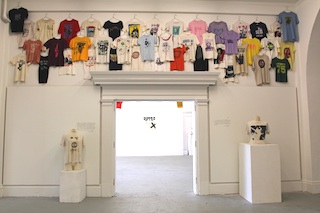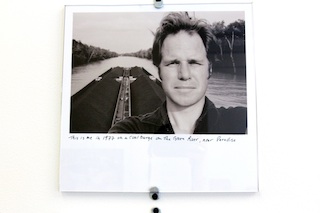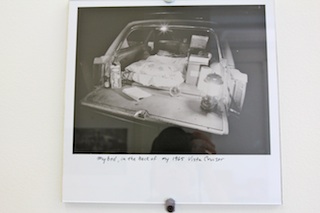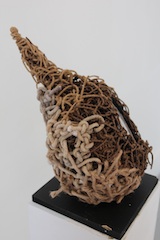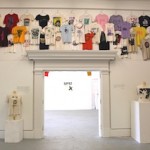El Campo de Mañana at LOT Louisville
By Julie Gross
Land of Tomorrow (LOT) Louisville is known to exhibit some of the most intriguing contemporary art in the area. Works that make you scratch your head and make you want to pull out your camera phone to take a pic. The 18,000 square foot gallery also isn’t afraid of exhibiting as many artists as the capacious building can hold. Case in point El Campo de Mañana featured four exhibitions including RIPPED, curated by Cesar Padilla, Photographs From the Kentucky Project by Bob Hower, Nests by Radford Brown, and Destroy Fashion by Patrick Thompson.
RIPPED is a collection of rare punk and post-punk music and art t-shirts from the 70’s and 80’s in all their faded glory. Musician and vintage clothing store owner, Cesar Padilla, has been collecting these historical cotton documents for the past 20 plus years and a portion of his tenacity is hanging high on LOT’s walls. The musty smell of antiquity looms in the air as you crane your neck to read the who’s who.
Depending on your age and musical interests, seeing a few of the shirts will send you back to the days of dark, beer infused bars or they will make you think “Oh yeah, I remember them.” The Damned, The Kinks, New York Dolls, Siouxsie and the Banshees and, unjustly hidden, Joy Division’s iconic Unknown Pleasures. There wasn’t a particular rhyme or reason to the display with the exception of an area paying homage to the Sex Pistols including a shirt claimed to have been owned by Sid’s destructive counterpart Nancy Spungeon.
The exhibit was previously on display in Los Angeles and seemed to include a more intentional exhibition opposed to t-shirts hanging on wire hangers (cue Mommy Dearest) that were out of reach and range for closer examination. The 208-page book, Ripped: T-Shirts from the Underground, which features pictures of Padilla’s entire t-shirt collection including text recollections from musicians and pop culture personalities is the better bet to chronicling an homage to this bygone punk era.
Documentary photography has been happening ever since the invention of the camera made it possible to capture 3-D images on 2-D paper. Momentous events such as the American Civil War, a survey of the unadulterated Great West and the Great Depression were captured on film and brought right to our doorstep in the form of a newspaper press photo thanks to adventurous photographers willing to get their hands dirty.
When the United States celebrated its 200th anniversary as an independent republic, national events were created to contribute to this remarkable commemoration. Photographer Ted Wathen devised the Kentucky Documentary Photographic Project, which folded nicely into the state’s contribution to the Bicentennial festivities. When he received funding to document Kentucky’s 120 counties over a three-year period from 1975 to 77; he called on two other experienced photographers, Bill Burke and Bob Hower, to help.
A collection of Hower’s photographs from the Kentucky Documentary Photographic Project encompassed a large hallway at LOT. Twenty of the photographs were large format (32 x 44”) inevitably causing the subject matter to command the full attention of onlookers. If you’ve never seen the back country of Kentucky or rural anywhere U.S.A. these black and white photographs will startle you, but in a captivating “look at that” kind of way.
The McGuire House in Leslie County is a simple shack that sits on a hill amidst the sticks and dirt; abandoned tires litter the front like a makeshift obstacle course. A lone telephone pole stands erect as an indicator of modern progress and a beacon to the front door.
Felix Blevins and Family, also in Leslie County, is a portrait of a junk dealer who lives among the wares that he sells. From afar, Felix and his two family members seem to blend in among the scattered refuse.
Detail
Included in the exhibit is a portrait of Hower at the time of the Project as well as a behind the scenes look at how he lived out of his 1965 Vista Cruiser adapting the vehicle into a make-shift dark room.
Hower writes, “We made a serious attempt to paint an honest picture of life in a particular place at a particular time.” Bob Hower, Ted Wathen and Bill Burke have created an intimate portrait of the people and places of Kentucky as well as assembling an important document of the state’s history. A portion of these photographs is in the collection at the Smithsonian American Art Museum.
Nests by Radford Brown are an intriguing study in rope manipulation, part half macramé half other worldliness designs that hang and protrude from the walls. The works were sparse, but showed promise as works of modern craft.
Destroy Fashion by Patrick Thompson were pages ripped from popular fashion magazines then manipulated by adding paper cross eyes on the models’ pristine faces and other paper additions reminiscent of a deranged criminal’s ransom letter. With all the recent Photoshop failures on fashion magazine covers it was only a matter of time until someone portrayed the absurdity of the industry.
- Pic9
- Pic8
- Pic7
- Pic6
- Pic5
- Pic4
- Pic3
- Pic2
- Pic1

